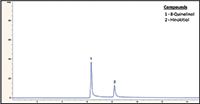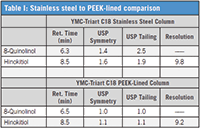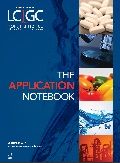Use of YMC-Triart C18 PEEK-Lined Columns for Improved Peak Shape of Coordination Compounds
The Application Notebook
Coordination compounds tend to exhibit poor peak shape when run on traditional stainless steel HPLC columns due to interactions with the metals used in column housings and frits. PEEK-lined columns and frits help minimize these issues by providing an inert environment for these types of analytes. This work highlights improvements in peak shape obtained for two coordination compounds (Hinokitiol and 8-Quinolinol) when run on YMC's new Triart C18 PEEK-lined columns, as compared to a standard stainless steel column.
Sample Preparation
Stock solutions of 1 mg/mL Hinokitiol and 8-Quinolinol were made using 50:50: H2O:ACN as the diluent. A standard solution (0.1 mg/mL) of both compounds was subsequently made using the same diluent.
Operating Parameters

This application began by first evaluating a separation of Hinokitiol and 8-Quinolinol using a standard stainless steel column. The column used for this part of the experiment was a 150 × 4.6 mm, 120 Å, 3 µm, YMC-Triart C18 column (part number: TA12S03-1546WT). The two coordination compounds exhibited low response and poor peak shape with excessive tailing as seen in Figure 1.

The analysis was then repeated on a 150 × 4.6mm, 120 Å, 3 µm, YMC-Triart C18 PEEK-lined column (part number: TA12S03-1546PTP). The improved performance can be seen in Figure 2.

In order to eliminate as many variables as possible, the procedure was run under the same conditions, same day, using the same mobile phases, samples, and instrument. Tabulated results of the different analyses can be seen in Table I.

In summary, the results indicate that YMC-Triart C18 PEEK-lined columns and frits outperform traditional stainless steel columns when used for analyzing troublesome coordination compounds such as 8-Quinolinol and Hinokitiol. These columns are also useful for other coordination compounds that contain phosphate groups in their structure such as ADP, ATP, and AMP. YMC-Triart PEEK-lined columns are available in all YMC-Triart stationary phases including C18, C18 ExRS, C8, Phenyl, PFP, and Diol-HILIC for extremely polar compounds. In addition to 3 µm and 5 µm particle sizes, these phases are also offered in 1.9 µm for high-throughput UHPLC analysis.

YMC America, Inc.
941 Marcon Blvd., Suite 201, Allentown, PA 18109
tel. (610) 266-8650, fax (610) 266-8652
Website: www.ymcamerica.com

SEC-MALS of Antibody Therapeutics—A Robust Method for In-Depth Sample Characterization
June 1st 2022Monoclonal antibodies (mAbs) are effective therapeutics for cancers, auto-immune diseases, viral infections, and other diseases. Recent developments in antibody therapeutics aim to add more specific binding regions (bi- and multi-specificity) to increase their effectiveness and/or to downsize the molecule to the specific binding regions (for example, scFv or Fab fragment) to achieve better penetration of the tissue. As the molecule gets more complex, the possible high and low molecular weight (H/LMW) impurities become more complex, too. In order to accurately analyze the various species, more advanced detection than ultraviolet (UV) is required to characterize a mAb sample.















